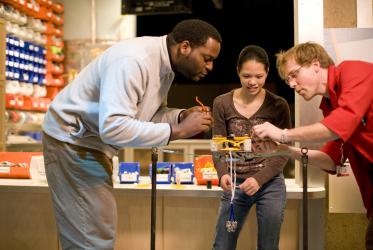The Museum of Science, Boston creates its own signature exhibits, programs, and shows that mix science, interactivity, and even humor to inform and amaze. As worldwide interest mounts for high-quality STEM (Science, Technology, Engineering, and Math) education, we renew and expand our mission to transform the public’s relationship with science and technology by creating new products for museums, educators, and businesses that span the globe.
For example:
• Recognizing a lack of engineering curricula, we established the National Center for Technological Literacy® (NCTL®) and piloted elementary engineering textbooks with eight teachers and 200 students in 2004. Today, our award-winning Engineering is Elementary® (EiE®) and other K–12 curricula have reached an estimated 106,000 teachers and 9.6 million students in the United States; all these K-12 curricula are available.
• Our partnership with Pixar Animation Studios created The Science Behind Pixar exhibition. Opened in Boston in June 2015, it reveals how Pixar combines art with science, technology, engineering, and math to create the world’s most iconic animated films. This exhibition produced our best summer attendance in 17 years, it starts touring in January 2016.
• More than 600,000 Museum visitors have built and tested 20 Design Challenges in our Exhibit Halls. These components feature hands-on activities pioneered to engage youth in the fun of engineering (like making and racing mini-bobsleds). Design Challenges programs and components can be customized for any institution.
• Innovators in digital production methods and space science story-telling, our Planetarium’s team of writers and artists produce stunning educational shows such as Undiscovered Worlds: The Search Beyond Our Sun, a study of exotic exoplanets; From Dream to Discovery: Inside NASA, focused on the engineering innovations developed to explore the universe; and Moons: Worlds of Mystery, investigating the surprising and revealing role moons play in our solar system. Shows can be customized for any Planetarium theater.
• Touring exhibits sized for small institutions include Beyond the X-Ray, an exploration of medical imaging technology; What I Eat: Around the World in 25 Diets, a photojournalist’s study of how different cultures approach and consume food; and Macro or Micro: Challenging Our Perceptions of Scale, photos and stories highlighting patterns in images of vastly different scales taken from satellites and scanning electron microscopes.
• In 2013, the Museum opened the Hall of Human Life, an exhibition of 70 interactive components aimed at revolutionizing how people engage with their biology and manage their health; we are exploring options to sell, rent, or license components and intellectual properties.
Everyone has a role in science and technology -- as learners, scientists or engineers, citizens or community leaders, workers, consumers, and stewards of our planet. Please consider using our repertoire to foster the knowledge and skills we need to make informed decisions about issues shaping our lives and our planet’s future.
For more information, including an extensive Education Enterprises brochure, please contact educationenterprises@mos.org. Visit http://www.mos.org/education-enterprises-and-traveling-exhibits or http://www.mos.org.

